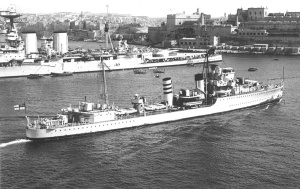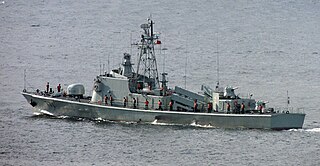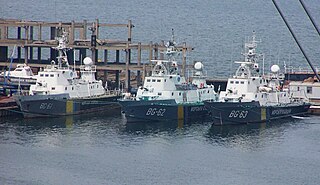
An anti-ship missile (AShM) is a guided missile that is designed for use against ships and large boats. Most anti-ship missiles are of the sea-skimming variety, and many use a combination of inertial guidance and active radar homing. A large number of other anti-ship missiles use infrared homing to follow the heat that is emitted by a ship; it is also possible for anti-ship missiles to be guided by radio command all the way.

HMS Inglefield was an I-class destroyer leader built for the Royal Navy that served during World War II. She was the navy's last purpose-built flotilla leader. She was named after the 19th century Admiral Sir Edward Augustus Inglefield (1820–1894), and is so far the only warship to carry the name of that seafaring family. In May 1940, her pennant number was changed to I02.

A patrol boat is a relatively small naval vessel generally designed for coastal defence, border security, or law enforcement. There are many designs for patrol boats, and they generally range in size. They may be operated by a nation's navy, coast guard, police, or customs, and may be intended for marine, estuarine, or river environments.

The Tarantul-class corvette, Soviet designation Project 1241 Molniya are a class of Russian missile corvettes.

The Israeli Navy is the naval warfare service arm of the Israel Defense Forces, operating primarily in the Mediterranean Sea theater as well as the Gulf of Eilat and the Red Sea theater. The current commander in chief of the Israeli Navy is Aluf David Saar Salama. The Israeli Navy is believed to be responsible for maintaining Israel's offshore nuclear second strike capability.

The Croatian Navy is a branch of the Croatian Armed Forces. It was formed in 1991 from what Croatian forces managed to capture from the Yugoslav Navy during the breakup of Yugoslavia and Croatian War of Independence. In addition to mobile coastal missile launchers, today it operates 30 vessels, divided into the Navy Flotilla for traditional naval duties, and the Croatian Coast Guard. Five missile boats form the Croatian fleet's main offensive capability.

LÉ Niamh (P52) is a Róisín-class offshore patrol vessel in the Irish Naval Service. The ship is named after Niamh, queen of Tír na nÓg, from Irish mythology. Commissioned in 2001, as of 2020 the ship was in active service.

LÉ Róisín (P51) is the lead ship of her class of offshore patrol vessel in the Irish Naval Service. Commissioned in 1999, the ship's primary mission is fisheries protection, search and rescue, and maritime protection operations, including vessel boardings. Róisín or Róisín Dubh, is often used as an allegory for Ireland. However, the original Róisín Dubh was a daughter of Red Hugh O’Neill, Earl of Tyrone in the late 16th century.

HMCS Charlottetown is a Halifax-class frigate that has served in the Royal Canadian Navy since 1995. Charlottetown is the tenth ship in her class which is based on the Canadian Patrol Frigate Project. She is the third vessel to carry the designation HMCS Charlottetown. Charlottetown, assigned to Maritime Forces Atlantic (MARLANT) and homeported at CFB Halifax, serves on missions protecting Canada's sovereignty in the Atlantic Ocean and enforcing Canadian laws in its territorial sea and exclusive economic zone. Charlottetown has also participated in several NATO missions, patrolling the Atlantic Ocean as part of Standing Naval Force Atlantic (STANAVFORLANT) and its successors Standing NATO Maritime Group 1 and 2. Charlottetown has also been deployed on missions throughout the Atlantic and to the Indian Ocean, specifically the Persian Gulf and Arabian Sea on anti-terrorism operations.

HMCS St. John's is a Halifax-class frigate that has served in the Canadian Forces and the Royal Canadian Navy since her commissioning in 1996. She is the eleventh of twelve ships in her class which is based on the Canadian Patrol Frigate Project. St. John's is named after the city of St. John's, Newfoundland and Labrador, a port city associated with Canadian naval history and heritage, and is the first ship in the Royal Canadian Navy to bear the name.

The 9M120 Ataka is an anti-tank guided missile (ATGM) originating from the Soviet Union. The NATO reporting name of the 9M120 missile is the AT-9 Spiral-2. It is the next major generation in the 9K114 Shturm family. The missile has radio command guidance and is also a beam riding SACLOS. This missile's primary variant was designed to defeat tanks with composite armour and explosive reactive armor. The 9M120 Ataka system is often confused with the 9K121 Vikhr system, despite being different weapons systems developed by different companies. The former was designed by the KBM machine-building design bureau and manufactured by the Degtyarev plant. According to the Stockholm International Peace Research Institute, Russia exported the Ataka ATGM to Iran, Kazakhstan, and Slovenia.

The AK-630 is a Soviet and Russian fully automatic naval, rotary cannon, close-in weapon system. The "630" designation refers to the weapon's six gun barrels and their 30 mm caliber.

The Slovenian Navy, officially the 430th Naval Division is not a separate service, but an integral part of the Slovenian Armed Forces.

USS Johnston (DD-821) was a Gearing-class destroyer of the United States Navy, the second Navy ship named for Lieutenant John V. Johnston, who served in the Navy during the American Civil War.

The Type 037 corvette is a series 400–500 ton corvette type classes in service with the People's Liberation Army Navy. Unlike western navies, the People's Liberation Army Navy does not have dedicated patrol boats in its inventory. Instead, a large variety of corvette type classes, in the form of missile boats and submarine chasers fulfill the tasks of patrolling China's territorial waters. The Egyptian Navy operates eight vessels.

The Stenka class is the NATO reporting name for a class of patrol boats built for the Soviet Navy and Soviet Allies. The Soviet designation was Project 205P Tarantul. The boats are an anti-submarine (ASW) patrol boat version of the Osa-class missile boat.

The Svetlyak class, Russian designation Project 10410 Svetlyak, is a class of patrol boats designed and built in the Soviet Union and later in Russia, and currently being used primarily by the Russian Navy and Russian Coast Guard.

Project 10412 class patrol boats are an export version of the Russian Svetlyak class patrol boat. These vessels are designed to carry out a variety of missions, from patrol missions to prevent violations of maritime state border, to protect friendly vessels and facilities from enemy surface and air attacks, to monitor exclusive economic zones, to protect natural resources areas and coastal lines of communications, etc.

Admiral Tributs is a Project 1155 Large Anti-Submarine Ship of the Russian Navy. Known in the west as an Udaloy-class destroyer, the ship is named after admiral Vladimir Filippovich Tributs. Launched in 1983, Admiral Tributs serves in the Russian Pacific Fleet, and has taken part in operations alongside the naval forces of other nations like China, India and Japan, and as part of a peacekeeping force in the Middle East between 1992 and 1993.

Vitse-Admiral Drozd was the third ship of the Project 1134 Berkut Large Anti-submarine Ships built for the Soviet Navy, also known as the 'Kresta I'-class or Admiral Zozulya-class guided missile cruisers. The vessel was commissioned in 1968 and served with the Baltic and Northern Fleets through the 1970s and 1980s. As well as taking part in naval exercises in the Atlantic, the ship assisted in the rescue of the crew of the stricken submarine K-19 in 1972. As a consequence, the ship was named in the Northern Fleet's book of honour. The vessel was reclassified a Large Rocket Ship in 1977 to reflect its multi-purpose capability. After an upgrade in 1981, Vitse-Admiral Drozd continued to operate in the Mediterranean Sea and Atlantic Ocean. The vessel observed the 1986 United States bombing of Libya and undertook good will visits to Annaba, Algeria, and Dubrovnik, Yugoslavia, as well as Tripoli and Tobruk. After being decommissioned in 1990, the ship was sent to India to be broken up in 1992 but sank en route.




















